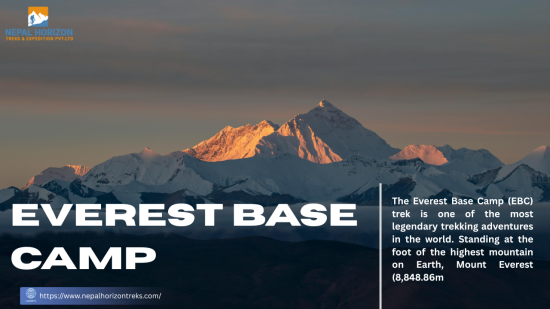Reach New Heights: The Ultimate Everest Base Camp Adventure
12th October 2025
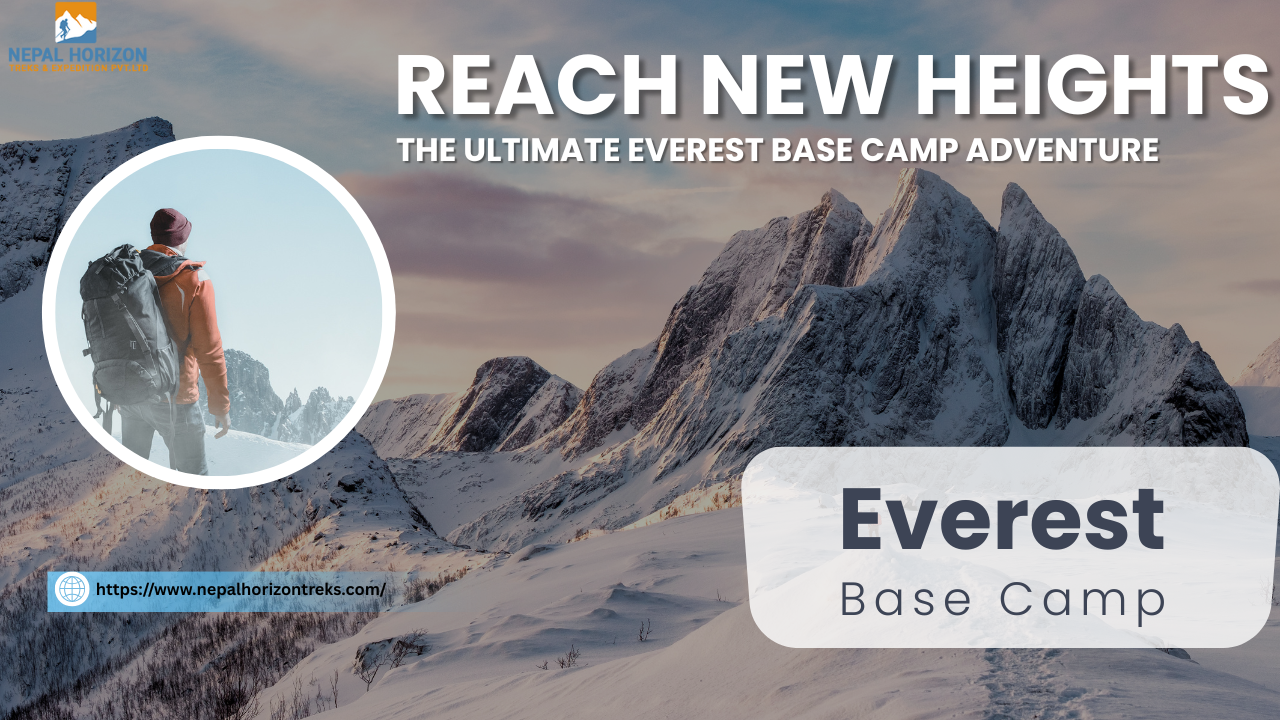
Embarking on the Everest Base Camp (EBC) trek is more than just a hike, it's a transformative journey into the heart of the Himalayas. This iconic trail offers breathtaking landscapes, rich Sherpa culture, and a profound sense of achievement. Whether you're an experienced trekker or a first-time adventurer, this guide provides everything you need to plan your Everest Base Camp experience.
Overview of the Everest Base Camp Trek
The EBC trek is a classic Himalayan adventure that takes you to the base of Mount Everest, the world's highest peak at 8,848.86 meters (29,031.7 feet). Starting from Lukla, the trail meanders through Sherpa villages, dense forests, alpine meadows, and glacial terrains. Along the way, trekkers are treated to panoramic views of towering peaks like Nuptse, Lhotse, and Ama Dablam. The journey culminates at Gorak Shep, followed by a short hike to Everest Base Camp itself.
Best Time to Visit
The ideal months for the EBC trek are:
- Spring (March to May): Offers clear skies, mild temperatures, and blooming rhododendrons.
- Autumn (late September to November): Provides stable weather, crisp air, and unobstructed mountain views.
Avoid trekking during the monsoon season (June to August) due to heavy rainfall and potential landslides. Winter treks (December to February) are possible but come with colder temperatures and higher risks of snowstorms.
Everest Base Camp Itinerary (14 Days)
A typical 14-day itinerary includes:
- Day 1: Fly from Kathmandu to Lukla, trek to Phakding
- Day 2: Phakding to Namche Bazaar
- Day 3: Acclimatization day in Namche Bazaar
- Day 4: Namche to Tengboche
- Day 5: Tengboche to Dingboche
- Day 6: Acclimatization day in Dingboche
- Day 7: Dingboche to Lobuche
- Day 8: Lobuche to Gorak Shep, visit Everest Base Camp, return to Gorak Shep
- Day 9: Gorak Shep to Kala Patthar, descend to Pheriche
- Day 10: Pheriche to Namche Bazaar
- Day 11: Namche to Lukla
- Day 12: Fly back to Kathmandu
This itinerary allows for proper acclimatization, reducing the risk of altitude sickness.
Trekking Route & Major Stops
- Lukla (2,860m): Starting point with a scenic flight from Kathmandu.
- Phakding (2,610m): First overnight stop amidst pine forests.
- Namche Bazaar (3,440m): Sherpa capital, offering acclimatization opportunities and stunning views.
- Tengboche (3,860m): Home to the famous Tengboche Monastery.
- Dingboche (4,410m): A quiet village ideal for acclimatization.
- Lobuche (4,940m): Gateway to Everest Base Camp.
- Gorak Shep (5,170m): Final settlement before reaching Base Camp.
- Kala Patthar (5,545m): The best viewpoint for Everest's south face.
Accommodation & Meals
Along the EBC trek, trekkers stay in teahouses—simple lodges offering basic amenities. Rooms typically have twin beds with shared bathrooms. Meals include a variety of options such as Tibetan bread, soups, momos, and pasta. Dal Bhat (lentil soup with rice) is a staple, providing essential energy for the trek.
Trekking Difficulty & Fitness Requirements
The EBC trek is considered moderate to challenging. While no technical climbing skills are required, the high altitude and long trekking days demand good physical fitness. Trekking 6–7 hours daily with ascents and descents is typical. Cardiovascular endurance, muscular strength, and mental resilience are crucial. Regular aerobic exercises like walking, jogging, or stair climbing can help prepare.
Cultural Experiences
The EBC trek offers rich cultural interactions with the Sherpa people. Visitors can explore Buddhist monasteries, observe traditional festivals, and learn about Sherpa customs and hospitality. The trail passes through villages like Namche Bazaar and Tengboche, where trekkers can experience the unique blend of Tibetan Buddhism and Himalayan traditions.
Safety, Permits & Guidelines
To trek to Everest Base Camp, two main permits are required:
- Sagarmatha National Park Permit: Approximately NPR 3,000
- TIMS (Trekkers' Information Management System) Card: Approximately NPR 2,000
These can be obtained in Kathmandu or at the park entrance in Monjo. It's advisable to trek with a licensed guide or porter for safety and cultural insights.
Gear & Packing Tips
Essential items include:
- Clothing: Layered clothing system (base layer, insulation, waterproof outer layer)
- Footwear: Sturdy trekking boots with good ankle support
- Accessories: Sunglasses, hat, gloves, and a headlamp
- Sleeping Gear: Sleeping bag rated as -20°C
- Health & Safety: First aid kit, water purification tablets, and altitude sickness medication
Remember to pack lights, as porters carry a maximum of 20 kg per trekker.
Cost & Travel Recommendations
The total cost for the EBC trek varies based on the package chosen. A standard 14-day guided trek can range from $1,200 to $2,000, including permits, accommodation, meals, and guide/porter fees. Flights to Lukla are approximately $180–$250 round trip. It's advisable to book with a reputable agency like Nepal Horizon Trek, which offers customized EBC trek packages.
Conclusion
Trekking to Everest Base Camp is a life-changing adventure that combines physical challenge with cultural immersion and natural beauty. With proper preparation, the right mindset, and support from experienced guides, you can achieve this dream trek.
Reach out to us to customize your EBC trek package and make your Himalayan dream a reality.
Contact Us:
Phone: +9779851183849
Email: info@nepalhorizontreks.com
Location: Thamel, Chhetrapati, Kathmandu, Nepal
Whether you are a first-time trekker or an experienced adventurer, Nepal Horizon Trek is here to ensure your Everest Base Camp experience is safe, memorable, and unforgettable.
FAQs
1. How long does the EBC trek take?
Typically, the trek takes 12–16 days, depending on the itinerary and acclimatization needs.
2. Is altitude sickness a concern?
Yes, altitude sickness is a risk. Proper acclimatization and hydration are essential.
3. Can I trek solo?
Solo trekking is not recommended due to safety concerns. It's advisable to trek with a guide or as part of a group.
4. What is the maximum altitude reached?
Kala Patthar, at 5,545 meters, is the trek’s highest viewpoint with stunning Everest views.
5. Are there medical facilities along the trail?
Basic medical facilities are available in major stops like Namche Bazaar and Dingboche. For serious conditions, evacuation may be necessary.
Embarking on the EBC trek is the journey of a lifetime. With the right preparation and support, you can reach new heights and create memories that will last forever.
Recent From Blogs

12th October 2025
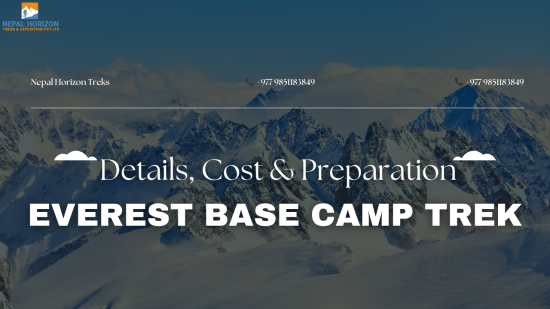
10th October 2025

7th October 2025

27th September 2025
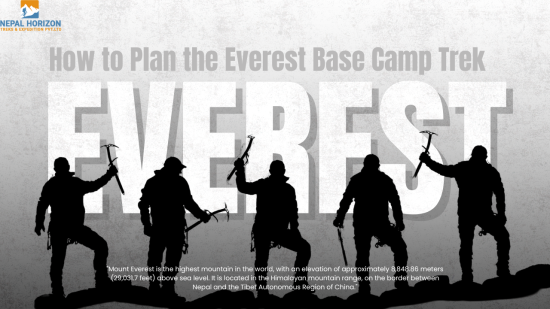
25th September 2025

22nd September 2025
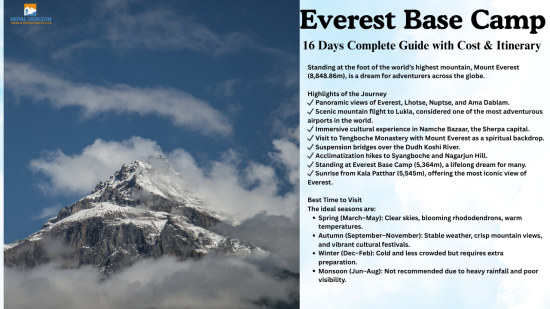
20th September 2025

17th September 2025
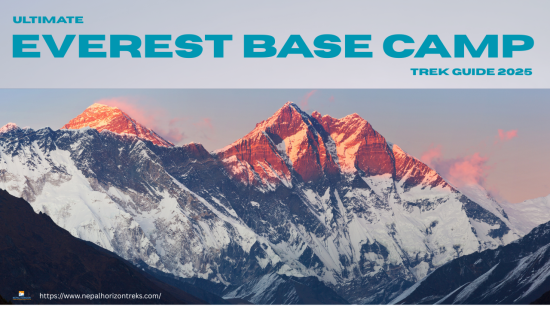
15th September 2025
